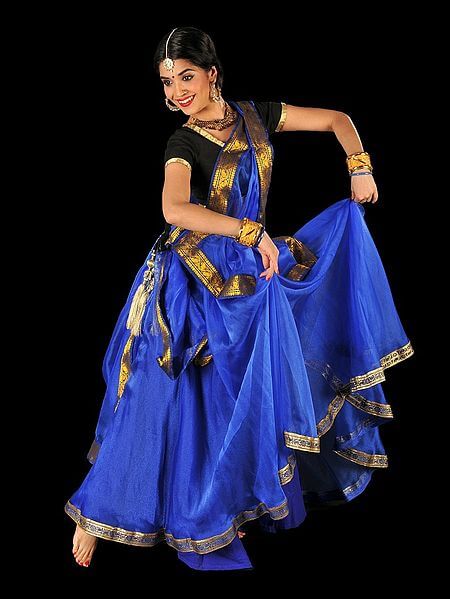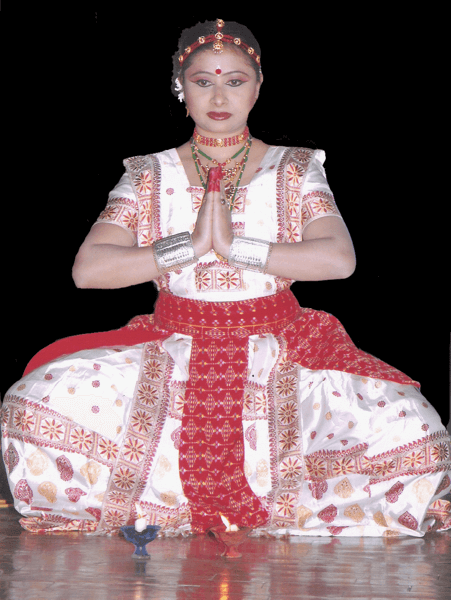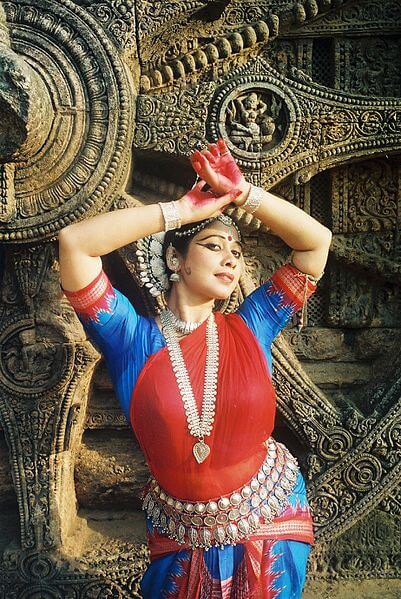Dances of India
Dances of India
Jasmine Trails Travel Guides
India the Continent masquerading as a country: Part 2

Like India, the Dances of India are equally diverse in their nature and origins. The Dances of India are broadly classified as classical or folk. The former are usually spiritual in content and the latter are also spiritual but are usually reserved for special cultural or religious events.
The oldest dance genres widely practiced today are from India. Indian dances including its classical styles are amongst the most ancient forms of dance surviving. Time has of course altered some of the elements of Indian dance, but the core is very much intact as it was two thousand years ago. Beautiful statutes of dancing girls have been discovered in India’s earliest civilizations namely Harappa and Mohenjo-Daro that date way back to 6000 BC.

Looking at this beautiful “Dancing Girl”, it is evident that dance form had achieved a sophisticated measure of discipline, though very little is known of dance techniques of this era. At this stage of antiquity, it is difficult to ascertain if dance had any connection with religion.
With the advent of the Aryans around 2000 BC and the consolidation of Indic and Aryan knowledge in the Sacred scriptures Rig-Veda, Sama-Veda, Yajur-Veda, and Atharva-Veda and several minor scriptures together with the two Epics and Puranas have a very close connection with classical Indian dance. This close linkage between the scriptures and dance led to the consolidation of knowledge of dance and drama in a shastra called Bharata Natya Shastra this shastra is regarded by many as the fifth Veda. The Natya Shastra is the foundational treatise for classical dances of India, with 6000 verses in 36 chapters and was completed between 200 BCE and 200 CE.
Dances of India have many forms:
These genres range from four to fifteen. The Natya Shastra mentions four, other sources differ in their classification of Indian classical dance forms. The classical dance forms recognized by the Sangeet Natak Akademi and the Ministry of Culture are:
Bharatanatyam from Tamil Nadu, Kathak from Uttar Pradesh, Kathakali from Kerala, Kuchipudi from Andhra Pradesh, Sattriya from Assam, Manipuri from Manipur, Mohiniyattam from Kerala and Odissi from Odisha.
In addition, Dances of India include:
Lavani from Maharashtra, Bihu from Assam, Chhau from Mayurbhanj in Odisha, Ghoomar from Rajasthan, Rouf from Kashmir, Garba from Gujarat, Bhangra and Gidda from Punjab.
A brief introduction to the Dances of India
Bharatanatyam from Tamil Nadu
Bharatanatyam is the oldest classical dance tradition of India and like all classical dances of India, is steeped in deep symbolism. Bharatanatyam is traditionally performed by a solo female dancer and the attire the dancer resembles a Tamil Hindu’s bridal dress.
Bharatanatyam combines gestures called Hasta (or mudras) and at least twenty asanas found in modern day yoga and dancer communicates using symbols in the form of expressive gestures and pantomime set to Carnatic music of south India.

Kathakali from Kerala
Kathakali is literally an enacted story written in Sanskritized Malayalam where ancient stories are dramatized. Of all the Dances of India Kathakali costumes are the most elaborate, consisting of head dresses, face masks and painted faces. The makeup process takes hours and typically these performances are a dusk to dawn affair.
Not surprisingly the classical Japanese dance Noh is in many ways similar to Kathakali and deploys numerous elaborate masks and costumes.
Kathakali involves actor-dancers in the front, musicians in the background on the right-hand side of the stage and the vocalists are on the front of the stage. Traditionally the actor-dancers were all males, however in recent years females are also being inducted into this role.

Kathakali has many elements of ancient Indian performing arts such as Kutiyattam and Krishnanattam, though detailed academic scrutiny reveals several differences. Kutiyattam is “one of the oldest continuously performed theatre forms in India, and it may well be the oldest surviving art form of the ancient world”.
A Kathakali performance is one of the highlights of Jasmine Trails Southers Splendours Tour. Click here to learn more about The Southers Splendours Tour.
Kathak from Uttar Pradesh
Kathak is derived from the Vedic Sanskrit word “Katha” which means “story” and “Kathakar” is the storyteller. The origins of this dance form can be traced back to the nomadic bards of ancient north Indian 400 BCE. These wandering minstrels, very much in the tradition of early Greek theater, communicated the stories of the Great Epics and mythology through the medium of music, song and dance. This art form has survived as an oral tradition and is taught verbally and through practice.
Kathak has three distinct styles, also known as “gharanas”. The Jaipur gharana focuses on foot movements, where the feet of the dancer are adorned with tiny bells called Ghungroos. The Lucknow and Banaras gharanas focus on hand movements and facial expressions respectively.
The costumes of Kathak dancers are an assorted mix depending on religion of the dancer, Hindu or Muslim.
For the Hindu female dancers, the costume has two variations. One is based on a Sari the other full-length light-weight skirt and jewelry is typically present in this version. For the Muslim female dancer, the costume comprises a skirt and includes close fitting churidar pyjamas, a head scarf and sometimes a long coat.
For the Hindu male performers, the costume is usually a silk dhoti draped around the waist and the upper body at times being bare.

Kuchipudi from Andhra Pradesh
Kuchipudi is one of the toughest and most demanding form of classical dance in India. Kuchipudi includes both singing and dancing by the performer as requires more skill and much more dedication than any other Dances of India.
Kuchipudi, one of the greatest Dances of India fell prey to the ridicule and wrath of Christian missionaries and British officials. In 1892 Christian missionaries launched the “anti-dance movement”, to ban such dance forms and in 1910 the Madras Presidency of the British Empire banned all temple dancing.
Very much like Kathakali, a Kuchipudi performance typically is performed at night. A unique feature of Kuchipudi is Kavutvams, where the dancer adds complexity to the performance with elaborate footwork and graceful aerobatics set to a particular rhythm of music.
Adding to the uniqueness of Kuchipudi are several regional banis (variations or styles) due to the creativity of gurus. These variations are grouped under the Margi styles and Deshi styles. Under the Margi styles, the following major variations exist, Vedayata, Veddangam, Bommalata, Perani, Chindu, Bahurupam and Pagativeshalu. Under the Deshi styles, the following major variations exist: Rasaka, Charchari, Bhandika and Kollata.

Sattriya from Assam
Sattriya originated in Assam. The 15th century Sankaradeva is credited for the modern-day form of Sattriya. As one of the greatest Dances of India from the east of the country, Sattriya was recognized as a classical dance by Sangeet Natak Akademi of India in in 2000.
Once the exclusive domain of bhokots (male monks), the dance is now performed by both male as well as female dancers. The themes portrayed in the one-act plays of Sattriya played relate to Krishna and Radha and sometimes other avatars such as Rama and Sita. These one-act plays Ankiya Nat and combine the aesthetic and the religious through a ballad, dance and drama and is performed in the Krishna-centered Vaishnavism monasteries of Assam.

Manipuri from Manipur
Manipuri dance, also known as Jagoi is a team performance that originated from the far eastern state of Manipur bordering Myanmar. Manipuri is known for its Vaishnavism themes, in particular the “Raslila” of the story of Radha-Krishna. This dance form also celebrates themes related to Shaivism, Shaktism and regional deities such as Umang Lai during festival of Lai Haraoba. A unique feature of Manipuri is that it is performed on a full moon nights.

Mohiniyattam from Kerala
Dances of India are usually not exclusive to an individual theme but the Mohiniyattam that originates from Kerala, is dedicated to “Mohini” the divine but enchanting female avatar of Lord Vishnu. Attam in Malayalam is literally rhythmic motion. As such Mohiniyattam is also the dance of the divine enchantress. The Mohiniyattam is traditionally a solo dance performed by female dancers.
According to Reginald Massey, in his authoratative “India’s Dances: Their History, Technique, and Repertoire”, Mohiniyattam’s history is unclear.
Mohiniyattam, like the other great Dances of India was also ridiculed by the Colonial masters of India and eventually banned as a result of Christian missionaries “anti-dance movement” or “anti-nautch movement” of 1892.
The repertoire of Mohiniyattam includes music in the Carnatic style, recitation may be either by a separate vocalist or the dancer herself. The song is typically in Malayalam-Sanskrit hybrid called Manipravalam.

Odissi from Odisha
Odissi also known as Orissi, is a major ancient Indian classical dance that originated in the Hindu temples of the eastern coastal state of India, Odisha. Odissi is considered to the oldest of the Dances of India and was performed predominantly by women. This dance’s antiquity notwithstanding, Odissi was the only dance from Indian present in Michael Jackson’s 1991 hit “Black or White”.
Traditional Odissi has two genres. The first genre “maharis”, is performed by female dancers and focusses on solemn, spiritual temple dances (the traditional “mahari” form of dance has been discontinued following abolition of the devadasi system). The second genre is known as “gotipuas”, perfected by boys dressed as girls and included athletic and acrobatic moves, and were usually performed from festive occasions in temples. Modern Oddisi and its reconstruction in the 1950s has diversified the art form and now men have joined the women and have added exciting aspects to this ancient dance.

Recommended reading:
If you are interested in the Dances of India and would like more detail on this subject, we at Jasmine Trails Travel Guides, strongly recommend the following scholarly tomes:
“India’s Dances: Their History Technique & Repertoire” by Reginald Massey and “Indian Dances, Their History and Growth” by Rina Singha, Reginald Massey
Madhavi Puranam is a leading authority on Dances of India and is the Chief Editor of “Nartanam” the quarterly journal on Indian dance, published by Sahrdaya Arts Trust, Hyderabad.
Jasmine Trails Travel Guides- taking you deeper into the subject. Dances of India is part of the “Continent Masquerading as a Country” series.
You might be interested in Stepwells of India. India the Continent masquerading as a country: Part 4




